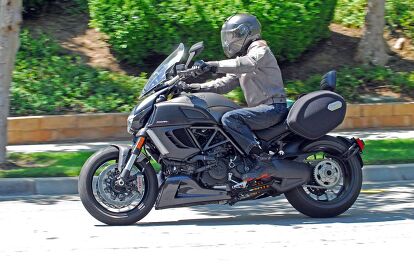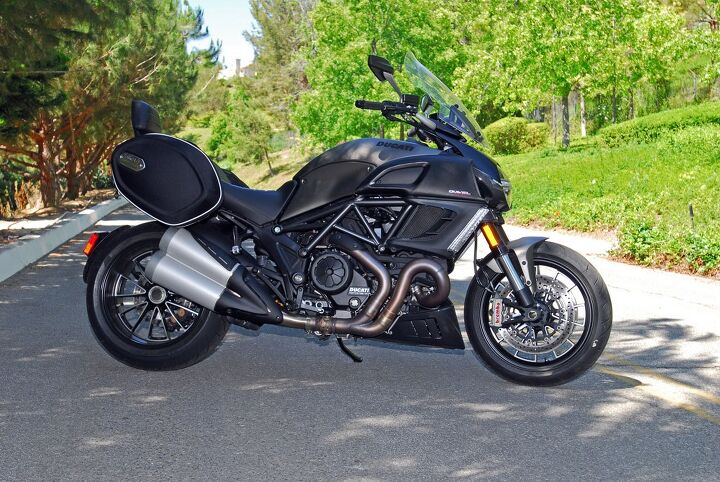2013/2014 Ducati Diavel Strada Review
Ducati’s Diavel has been an odd Duc since its 2011 inception, going partway down a cruiser path but not fully committing to the segment’s form-ahead-of-function paradigm. The regular Diavels can feel a bit confused – it’s sort of a cruiser but one from a new sub-breed.
Ducati Diavel Strada
| Engine | 19/20 |
| Suspension/Handling | 8/15 |
| Transmission/Clutch | 6.5/10 |
| Brakes | 10/10 |
| Instruments/Controls | 4.5/5 |
| Ergonomics/Comfort | 8/10 |
| Appearance/Quality | 8.5/10 |
| Desirability | 8/10 |
| Value | 7/10 |
| Overall Score | 79.5/100 |
And now comes the Diavel Strada, a touring-oriented version of the Italian devil that adds such niceties as a windscreen, saddlebags, higher handlebars with heated grips, and a plusher seat that includes a passenger backrest. While this would seem to dilute the animalistic appeal of the original Diavel, the Strada actually makes a bit more sense as a complete package – a comfortable and potent bagger, like an Italian-style Street Glide, the best-selling motorcycle in America.
A Street Glide, however, can’t match the Diavel’s 9.95-second sprint down the quarter-mile, as evidenced in the shootout listed above with the Cromo version of the Diavel. The 1198cc V-Twin kicks out 135 horses to a fat, 240mm rear tire, giving the 527-pound Diavel a potent power-to-weight ratio. The Strada version, at 540 pounds with its 4.5-gallon (claimed) tank full, should be almost as quick.
Also see the Diavel Cromo vs. the Star VMAX on the street and at the dragstrip
The core of the Diavel is unchanged: engine tuning, gearing, rake (28 degrees), wheelbase (62.6 inches) and seat height (30.6 inches) remain the same. New to the Strada are a higher-output generator to juice dual 12-volt power outlets, revised (non-retracting) passenger footpegs and a subtly altered rear lighting assembly.
First impressions are, for a Ducati, of a large, long and bulky machine, but keep in mind it carries around a massive 260 pounds less than a Street Glide and has 3 fewer inches between its axles. As such, relatively speaking, the Strada is a streetfighter among traditional baggers, with footpegs nearly under a rider’s butt as opposed to a cruiser’s feet-forward layout. The Strada’s new handlebars skew nearer to a cruiser, gaining 15mm (0.6 inch) in height and pulled 60mm (2.4 inches) closer to the rider.
Carried over from the other Diavels (base model, Dark, Carbon, losing the Cromo and AMG for 2014) is the bike’s imposing presence. The liquid-cooled motor is stuffed inside a tight-fitting trellis frame, and the back end is dominated by a fat donut (240mm) of a rear tire. The single-sided swingarm proudly displays a lovely aluminum wheel highlighted by machined accents.
Fired up, the Strada retains the Diavel’s slight grumpiness at very small throttle openings and a fairly heavy clutch pull. Also, its gearbox is somewhat clunky and requires longish throws, with neutral occasionally difficult to access at a stop.
Otherwise, the Diavel is delightful, feeling almost like a Honda Grom next to a typical bagger. Once past 1500 rpm, throttle response is pleasingly devoid of jumpiness, even in its performance-oriented Sport setting. A 70-degree steering sweep makes the bike easy to position in tight spaces, and the taller handlebar yields more leverage when trying to overcome the heavy steering responses created by that fat rear Pirelli.
The V-Twin in the Diavel is far revvier than any cruiser, yet it boasts stupendous midrange power that’ll annihilate any other V-Twin at the stoplight GP. The traction-control system makes the bike impossible to flip over when accelerating off the line, but it satisfyingly allows second-gear, 50-mph wheelies! True hooligans can switch off the TC. Meanwhile, you’ll be enjoying the crackling, raucous tunes played by a lightly muffled exhaust – loud enough to dissuade me from considering the aftermarket.
COMPARISON: Harley-Davidson CVO Street Glide Review
The Diavel is not only easy to launch, it’s also easy to bring to a stop. Braking performance from the triple-disc Brembo system is exceptional, with a firm lever actuated by steel braided lines and, up front, to stout radial-mount monobloc calipers. A relatively long wheelbase keeps the bike stable during heavy deceleration, and the standard ABS system rarely intervenes.
Out on the open road, the Diavel accelerates stronger at 80 mph (4800 rpm) than at 65 mph (3500 rpm), which is something no stock Harley ever could say. Its freeway-speed jam is outstanding and makes short work of any dawdlers in your path. It’s very solid and stable on the highway, where the pilot enjoys a fairly smooth ride thanks to the the long (for a Ducati) wheelbase that capably smothers most bumps. Passenger impressions are less favorable, as that heavy rear hoop and tire directly below your pillion is being ineffectively damped. Big bumps transmit considerable harshness to both riders, even after trying several settings on the suspenders. The shock features a hydraulic preload adjuster to allow easy changes to suit varying loads, even on the fly.
The fat rear end not only extracts a penalty from suspension compliance, it also degrades turn-in responses and linearity while altering bank angles. The relatively tall profile of the Pirelli helps the Diavel steer better than any other bike with a 240mm meat, but while no one can doubt the badassitude of the chubby back tire, it can’t help but compromise vehicle dynamics.
The Diavel boasts a two-tier instrument display that offers a comprehensive set of gauges. Attached to the handlebar is a gray-scale display for speed, oil temp, clock and bar-graph tach headed by an array of warning lamps. Atop the fuel tank is a color TFT panel with ambient temp, GPI, dual tripmeters, average and instantaneous fuel mileage, power mode and DTC settings. Like on many Yamahas, the Diavel has a convenient count-up tripmeter that engages when reserve is reached. We averaged nearly 40 mpg during our 500-plus miles on the Strada.
Another electronic trick is the Diavel’s keyless ignition with a proximity sensor. Journalists, who tend to switch bikes often, dislike such electronic ignition locks. But such locks are incredibly handy if you’re the only rider – just keep it stuck in your pocket and never worry about your key again. Anyone concerned about maintenance on a Ducati should know the Diavel is equipped with a two-year warranty, and valve-adjustment intervals have been stretched to 15,000 miles.
Conclusion
The transformation from Diavel to Strada has endowed this oddball platform with broader-band appeal. No longer just a muscle cruiser, the new equipment on the Diavel Strada stretches it into the sporty-touring category, offering range-extending comfort for both rider and passenger. It makes us want to load up 82 liters of luggage for a weekend getaway with a loved one to the next state over.
Okay, it’s not like we shelled out the $19,495 MSRP for our test bike, which, in case you hadn’t noticed, is a considerable chunk of change. But a base-model Street Glide now retails above $20k, and, while it has an audio system and GPS, it lacks traction control, standard ABS and the ability to make pass after pass down the quarter mile in less than 11 seconds. Oh, and a Street Glide does crappier wheelies!
+ Highs
- Fun and unique
- Versatile powerhouse
- Metrosexual Street Glide
– Sighs
- Wide/heavy rear wheel/tire
- Spendy
- Metrosexual Street Glide
More by Kevin Duke
























































Comments
Join the conversation
I'll have one.The Diavel in it's shopping edition was out because I wouldn't make my wife sit on that poor excuse for a pillion perch this one looks do-able.
Will be investigating hard bags though.
The Italians took something ugly, and made it even cheaper looking! The Diavel...isn't easy to look at...then they did this... Sorry, not a fan of any Strada...some scooters look better and I HATE scooters! Total FAIL!